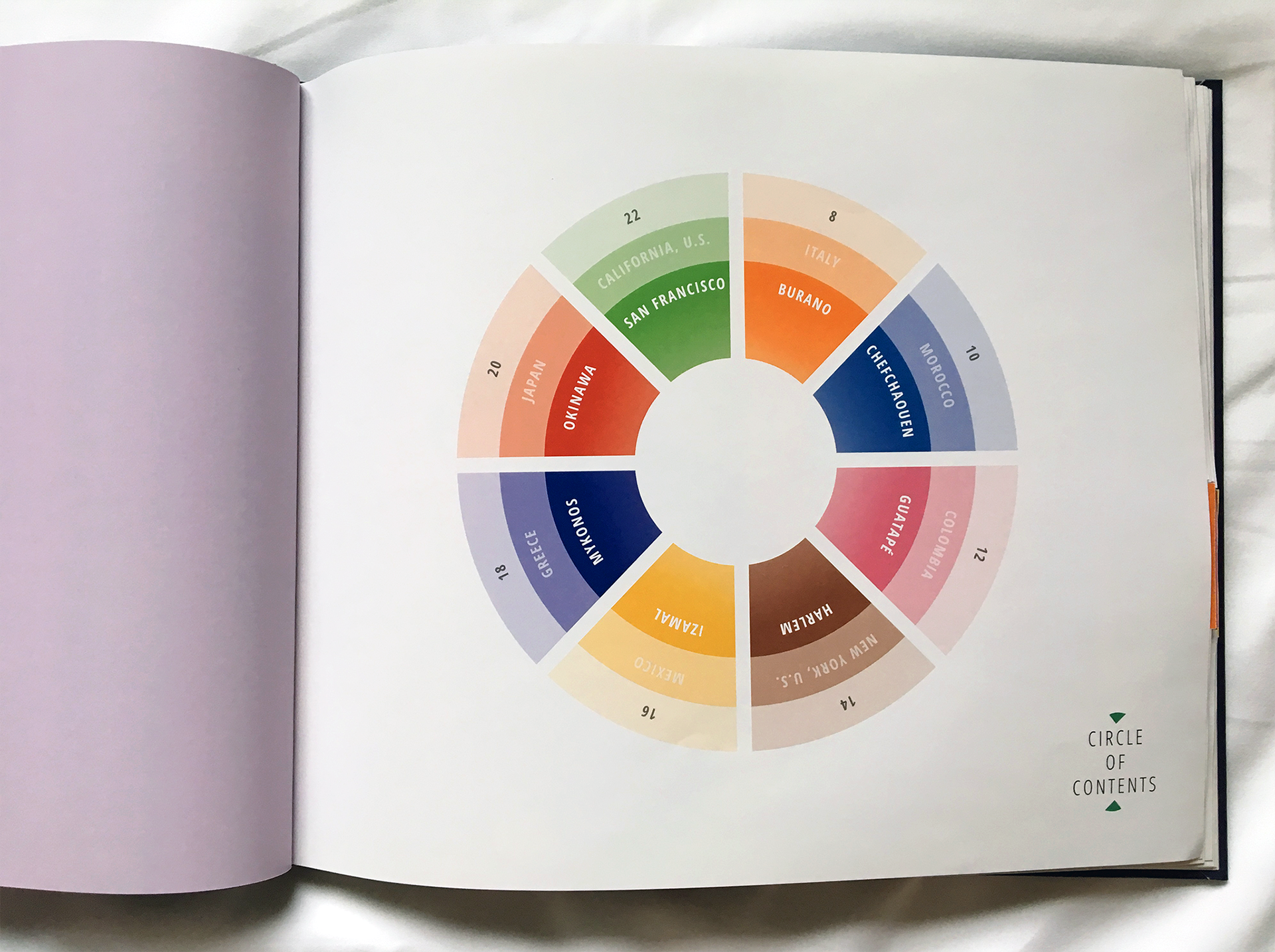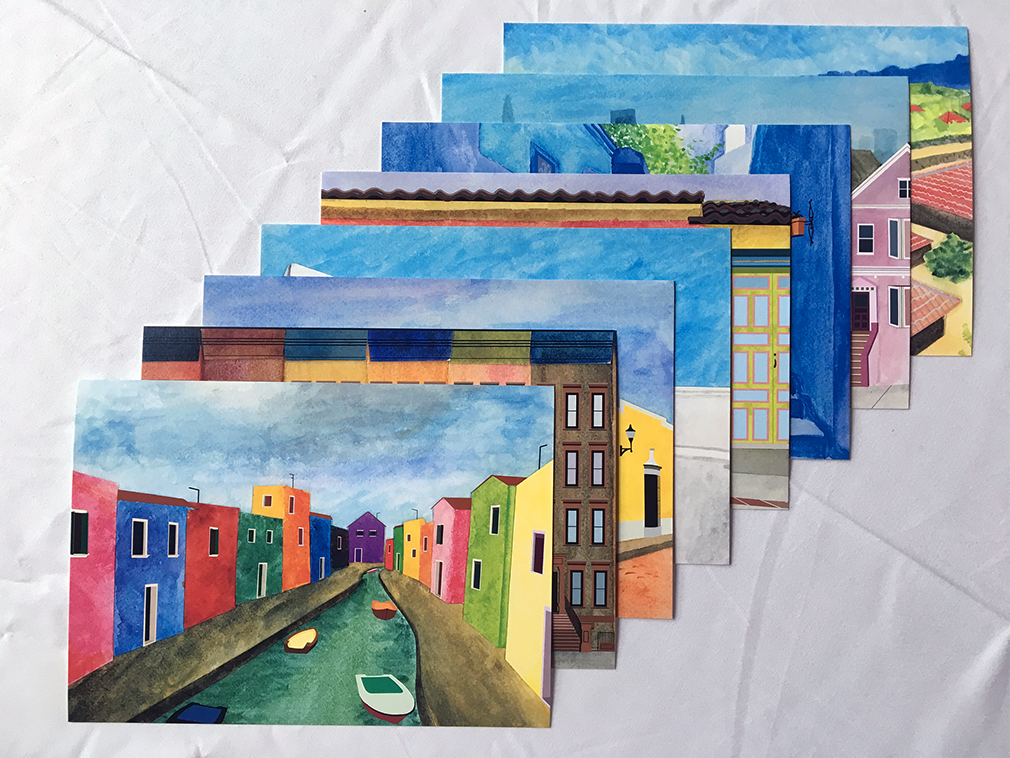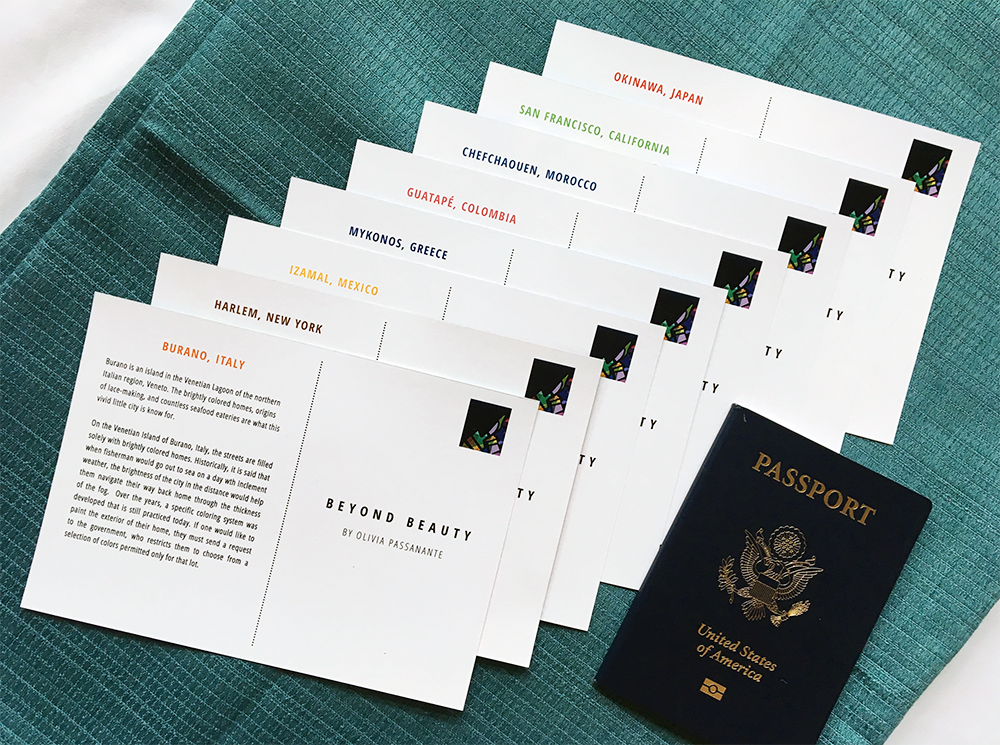Interactive book
Challenge: In many cities around the world, color is used on the exterior of homes for purposes beyond fueling a beautiful aesthetic, hence the title, “Beyond Beauty.” Oftentimes, the purpose behind the use of color in domestic architecture can help us discover more about a city's rich history, along with the people and cultures that exist within it. I chose to explore this concept and challenge myself to find the best design solution for documenting my research.
Solution: Developed a design solution in the form of an interactive book. Split up into eight different chapters by city, this book takes the reader on a colorful, architectural, cultural, and educational journey. Within each chapter, you’ll find a watercolor painting that has been transformed into a digital illustration, a dissected color palette, and the accompanying text describing the purpose behind the use of color in each city.






Each postcard includes an illustration of the city and it's matching color information.
Burano, Italy
On the Venetian Island of Burano, Italy, the streets are filled solely with brightly colored homes. Historically, it is said that when fisherman would go out to sea and experience inclement weather, the brightness of the city in the distance would help them navigate their way back home through the thickness of the fog. Over the years, a specific coloring system was developed that is still practiced today. If one would like to paint the exterior of their home, they must send a request to the government, who then allows them to choose from a selection of colors only permitted for that lot.
Chefchaouen, Morocco
There are a few theories behind the use of the different shades of blue, but the most widely believed is that it originated with the settlement of Jewish refugees fleeing from the Spanish Inquistion during the 15th-century. Legend has it that for the large population of settlers, blue mirrored the sky and was intended to remind them of God. When the Jewish population grew again with more people fleeing Europe during WWII, the blue paint spread to streets beyond the Jewish quarter and then around the whole city. Many of the Jews relocated in the 1950's, but the color has remained ever since, due to the abundance of tourists that come to experience the beauty every year.
Guatapé, Colombia
The residents of Guatapé have been painting their homes and businesses with colorful fresco-like panels called "zocalos" since the early 20th-century. Many of these paintings utilize bold shades of every color imaginable. While some zocalos represent the historical significance of the town, such as a commemorated journey of citizens, or musical instruments marking the house of a famous local musician, many are simply created for colorful decoration. Some panels include only colors and shapes, or sunflowers, sheep, and doves, which are popular images to display. Others are more practical, portraying bread loaves on the outside of a bakery, or sewing machines on the outside of a clothing store.
Harlem, New York
Although the brownstone material had been used for stoops and doorway trim during the early 19th-century, by the 1840's it became the most fashionable material to use for row houses. The Romantic Classicism style that glorified picturesque nature was believed to be reflected in brownstone, and the dark browns, greys, and greens were in high demand at that time. The material was also considered more honorable than wood or brick. However, with the spark of the Industrial Revolution and steam-powered machinery, brownstone was able to be produced faster and cheaper than ever before, making it more affordable for middle class homes as well.
Izamal, Mexico
The vivid, Yello ochre color covering the homes of Izamal represents how important religion was to the Mayans. Kinich Kakmó is Mayan for, "the fire macaw with the sun face", while Kinich Ahau is, "face of the sun". Both names were seen as the same solar diety in different forms, macaw and human. The sun was a powerful symbol for the Mayans, as their religion revolved around astronomy, nature, and rituals. The yellow color used on the exterior reflects the idea of their God representing a form in nature, for example, the sun.
Mykonos, Greece
The famous white and blue color scheme emerged for a few different reasons. White was used to paint over the original volcanic stone, allowing the structures to reflect the harsh sunlight and keep their interiors cool. Citizens were permitted to paint their homes any color, but blue was the cheapest and most readily available. Mixing a blue-tinted cleaning agent, called loulaki, with limestone plaster would leave them with a blue solution. In 1967, the military government that held power in Greece felt that the color scheme showed unification and supported their political agenda. As the islands became a well-known destination for tourists, a law was created in 1974 declaring that all houses must be painted white and blue.
Okinawa, Japan
The red clay tiles used in the construction of the rooves are produced from natural materials found on the island. The clay is taken from soil in the ground, which is then cut and fired by Okinawan artisans. Originally, ordinary people were not permitted to use the bright red tiles for the rooves of their houses. Red symbolized nobility years ago, which is why Shuri Castle (the rebuilt palace of the Ryukyu Kingdom) was constructed with the tiles. In 1889, the ban on the use of the tiles was lifted, which prompted the people of Okinawa to begin using them. Ultimately, the architecture of the traditional houses is designed to protect the residents from harm.
San Francisco, California
Victorian and Eduardian houses were built around the city of San Francisco between 1849 and 1915. Having gone through a period of colorful exteriors, to being painted in battleship gray during both World Wars, these houses have lived through a lot of history. In 1963, artist Butch Kardum started covering his house with vivid blues and greens. He became a color artist, and then proceeded to transform the exteriors of other houses into Painted Ladies. He did this with the help of other artists and colorists. By the 1970's, this process came to be known as the colorist movement due to the shift it caused for many houses and neighborhoods around the city. Today, this process is still practiced.